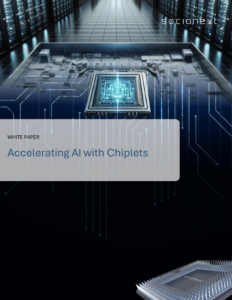The rapid growth of AI and machine learning workloads is pushing the boundaries of compute capacity, driven by advancements in multi-core processors, GPUs, and specialized AI accelerators. However, as individual nodes struggle to handle large-scale tasks, the industry is shifting towards parallel processing architectures with multiple processing elements (PEs) linked via high-speed interconnects. While compute power is expected to grow tenfold in the next few years, I/O bandwidth is lagging, projected to grow at a considerably lesser rate, creating significant bottlenecks.
This white paper titled "Accelerating AI with Chiplets" explores how chiplets can accelerate AI by addressing the challenges of scaling compute capabilities and interconnects, ultimately paving the way for more efficient and scalable AI systems.
Growth Drivers and System Design Challenges
 AI’s exponential growth is driven by algorithms, data, and compute performance. Machine learning techniques and open-source advances have made algorithms more complex, with breakthroughs like transformers enhancing AI capabilities. Data creation is accelerating, generating vast amounts of labeled and unlabeled data daily, which fuels AI but requires significant processing power and memory bandwidth.
AI’s exponential growth is driven by algorithms, data, and compute performance. Machine learning techniques and open-source advances have made algorithms more complex, with breakthroughs like transformers enhancing AI capabilities. Data creation is accelerating, generating vast amounts of labeled and unlabeled data daily, which fuels AI but requires significant processing power and memory bandwidth.
Compute power is crucial for AI, with a shift from standard ASSPs to custom SoCs designed with tightly coupled processing elements, high-bandwidth memory, and high-speed interconnects. These systems must scale up and out efficiently. As data and models scale, they are processed in parallel or in a pipeline, but interconnect bandwidth decreases from ASIC cores to inter-die and inter-ASIC connections.
Efficient scaling depends on interconnect speed and bandwidth, but current chip-to-chip links like PCIe and Ethernet are not evolving as fast as compute capacity, leading to higher costs and scalability issues, which extend time-to-market and increase development costs.
The Promise of Chiplets
ASIC designs are reaching their physical limits due to factors like reticle sizes, cost, complexity, and power consumption. Continuous redesigns are becoming less viable as system requirements evolve faster than hardware development.
Chiplets offer a solution by partitioning key functions into separate modules, allowing for optimized computing power and easier design evolution through modular upgrades. However, their effectiveness depends on optimizing interconnects to match the performance scaling of compute elements.
Chiplets enable more efficient and scalable AI systems by modularizing key functions and optimizing interconnects, ensuring hardware can keep pace with complex algorithms and massive datasets.
Read the full whitepaper, "Accelerating AI with Chiplets" or reach out to us via the Contact Us page to learn more.
Guna Shekar
Author of "Accelerating AI with Chiplets"
 Guna is the Director of Marketing and Business Development at Socionext and a member of the Global Leadership Group. He has over 25 years of experience in the VLSI industry, holding senior management roles in engineering, product management, marketing, and business development. He has worked at LSI Logic (now Broadcom) and several Silicon Valley startups before relocating to India.
Guna is the Director of Marketing and Business Development at Socionext and a member of the Global Leadership Group. He has over 25 years of experience in the VLSI industry, holding senior management roles in engineering, product management, marketing, and business development. He has worked at LSI Logic (now Broadcom) and several Silicon Valley startups before relocating to India.
Now based in Socionext’s Bangalore office, he is passionate about technical writing and organizational culture. In his free time, he enjoys playing sports and spending time with family and friends.

